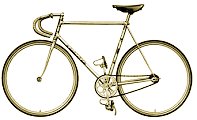The Viking Cycle
Company
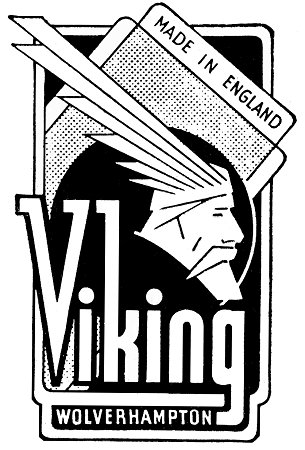 |
The Viking Cycle Company was formed in 1908 by
Alfred Victor Davies at 5 Wolverhampton Road, Heath Town. Before
the turn of the 20th century he worked as a railway
clerk in North Wales and was transferred to Wolverhampton.
The
Davies family lived in Heath Town because it was close to the
railway station. In those days a job on the railways was very
secure and if you wanted it, you had a job for life.
Although
the security was good, the pay was poor and Alfred had a wife
and three children to support. He started earning extra money in
his spare time by mending bicycles.
Cycling was very popular at
the time and so there were plenty of customers. He also started
the first motorcycle repair shop in Wolverhampton. |
| When working on the railways you
were not allowed to do any other work than for your employer.
The railway company found out about his repair business and he
was told that he had to give it up immediately or leave the
railway.
He decided to continue with the business and so he left
his job. This was a tremendous decision considering that he had
the family to support. |
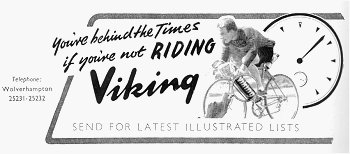
From a 1953 advert.
|
 |
It was an uphill struggle at first and the company
eventually outgrew the Heath Town premises and in 1928 moved to
larger premises in Broad Street. The exact location of the shop
is unknown, but it’s believed to have been on the right-hand
side of the street as you go towards Heath Town, near Fryer
Street. Viking were only there for a few years because the
company soon outgrew these premises, and in 1934 moved to
Midland Chambers at 34 Princess Street, where the betting shop
is today.
A year later a building was acquired around the corner
in Princess Alley to house the works, the Princess Street shop
becoming the showroom and offices. Around this time Viking
started making frames and so changed a bicycle assembler to a
bicycle manufacturer. |
| Alfred Davies retired just before the Second World
War and was succeeded as Managing Director by his son, Reg
Davies. Reg got a scholarship to the Grammar School and did very
well, coming first or second in every subject.
Unfortunately the
family couldn’t afford to send him to University, which was a
common thing in those days, and so he helped his father in the
family business and stayed there for the rest of his working
life. He built the business up from a small undertaking in the
1930s to a large scale manufacturing concern, producing around
20,000 cycles a year.
Viking Cycles Limited was formed in 1939 when the company
produced about 800 cycles a year. During the war bicycle
production ceased and the company was involved in munitions
work.
After the war, production rose to 2000 cycles a year and
the company decided to form its own road racing team. Bob Thom joined the company as a player-manager
for Viking’s first lightweight cycle team and Reg Davies
designed a couple of lightweight machines. |
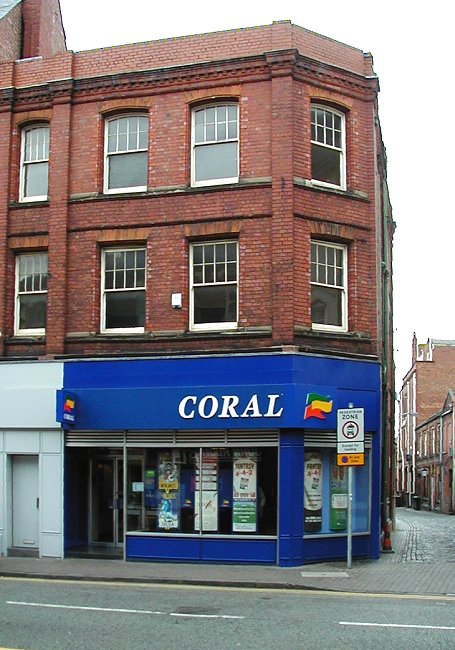
The Viking shop, as seen in 2002. |
|
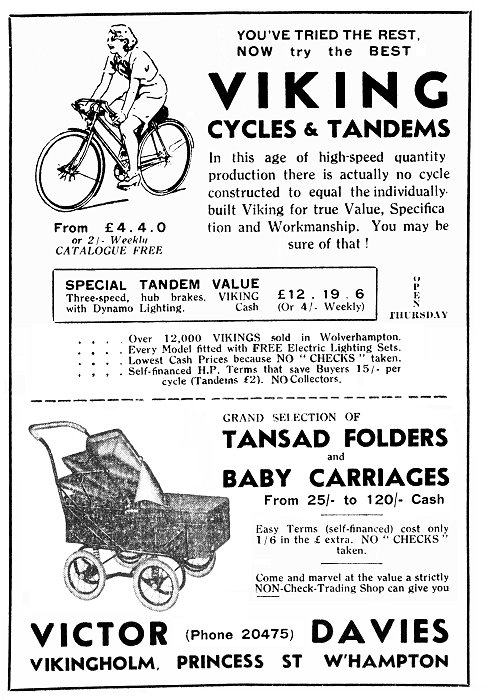
An advert from 11th May, 1937. |
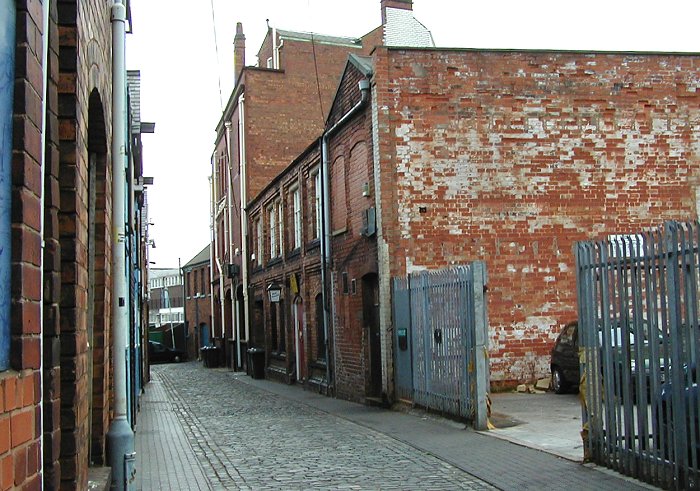
The old Viking works in Princess Alley.
|
The Viking road racers were introduced in 1948. Bob Thom was
a brilliant racing cyclist who led the team to many victories.
He started competitive cycle racing in 1935 and became a member
of the successful Wolverhampton Wheelers team with Percy Stallard and Ray Jones.
Bob came 6th in the first N.C.U.
massed start race at Donnington Park and won the first Midland
Centre massed-start championship with the Wheelers taking the
team prize. After the war he continued with the Wheelers and
became Independent Road Champion when the British League of
Racing Cyclists was formed. He was also in the first B.L.R.C.
team to compete abroad. Bob’s other success included a win in
the 100 Kilos Circuit of Dudley, a win in the Grand Prix at
Weston Super Mare and a win in the first Severn Valley Grand
Prix, which he repeated in 1848. He also won the notorious ‘Tour
of the Peaks’. |
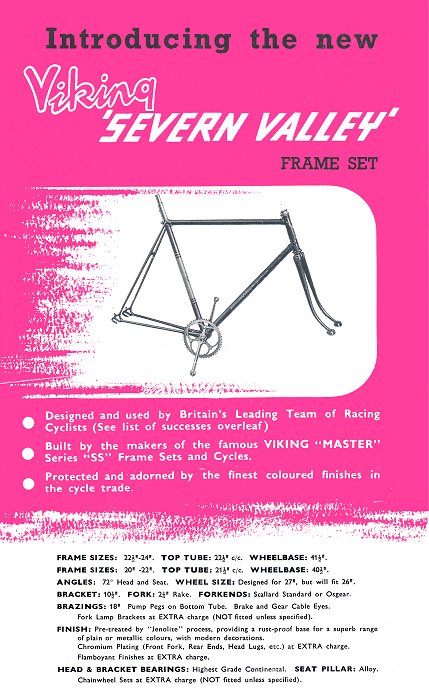
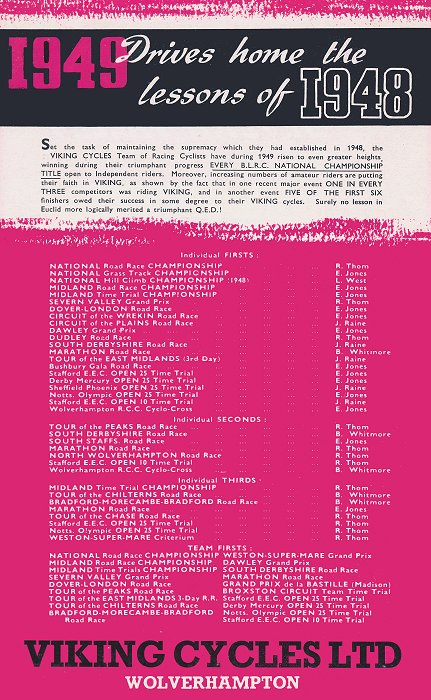
The 1955 Viking racing team.
Left to right:
Bev Wood, Doug Booker, Les Gill, Ian Steel, Ken Jowett.
Courtesy of the late Jim Boulton. |
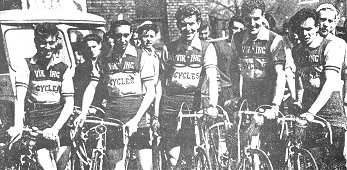 |
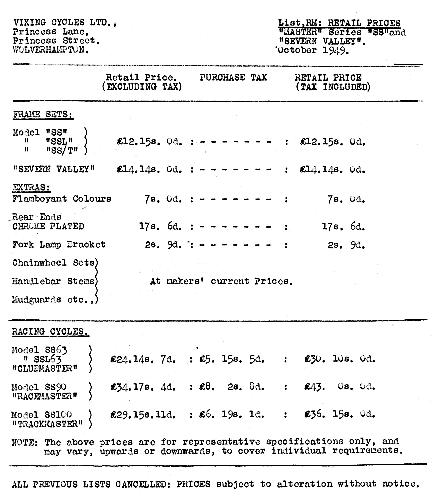
| Viking’s first cycling team also included Ben
Whitmore and Bill Allen and Bob led the team to victory in the
B.L.R.C. championship in 1948, 1949 and 1951. Another team
member Ian Steele, won what was perhaps their most important
triumph when he came first in the first Tour of Britain in 1951. |
| |
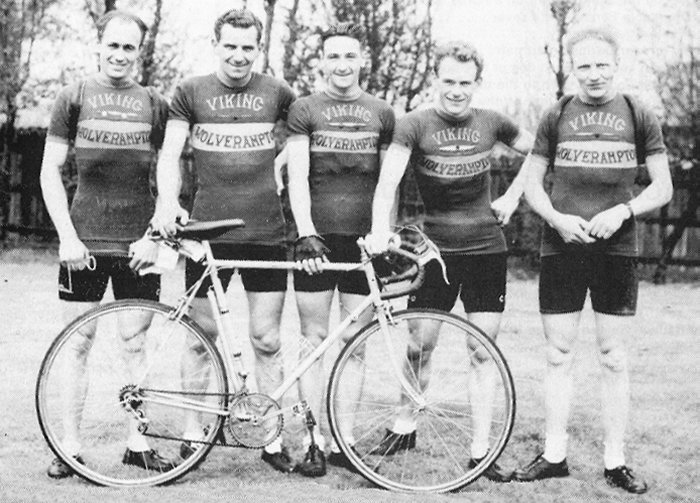
The 1951 Viking Tour of Britain team.
Left to right: Ben Whitmore, Bob Thom, Fred Nicholls, Johnny
Welch, and Ted Jones. |
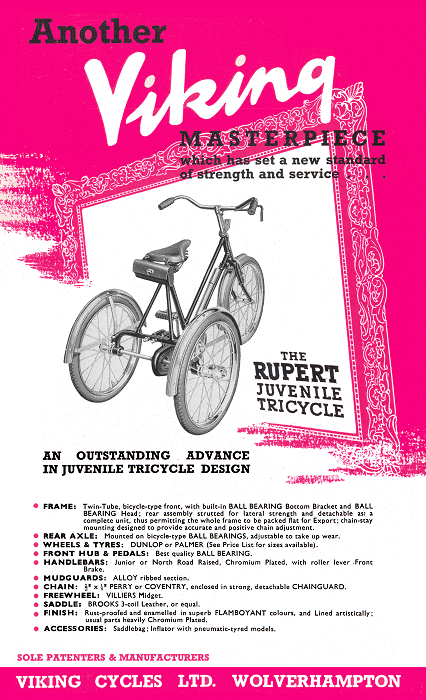
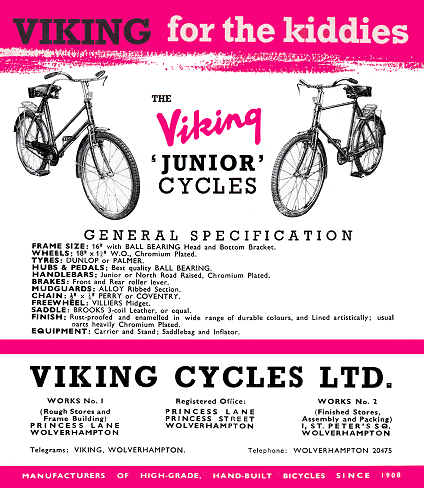
| Prior to Viking’s success in lightweight road racing the company
made large numbers of heavier roadster machines, because there
was an almost unlimited market for them, particularly during the
post war years. Viking’s name soon became synonymous with racing
because of the team’s many successes and the sport was very
popular. In those days there were less cars and so the roads
were not so full, and many massed-start bicycle road races were
held every year. Racing brought the company an enormous amount
of business. Club riding was very popular and large numbers of
people purchased club-type machines. |

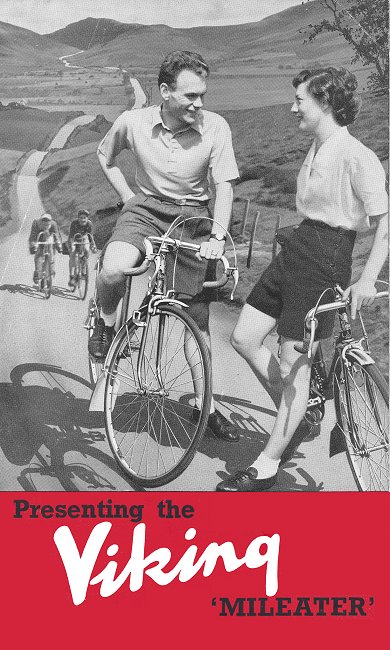 |
The couple in the photograph are
Dorothy and John Welch. John was 5th in the 1954 Tour of
Britain, in the Viking team, and Dorothy was 1949 national
Hill Climb Champion. |
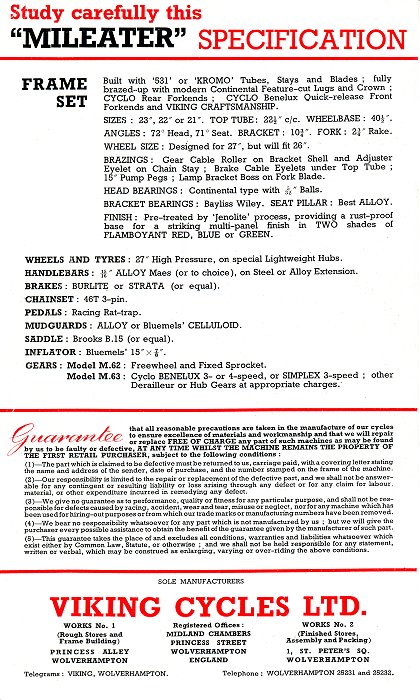
| Viking had 1250 bicycle dealers
throughout the country supplying club-type machines and became
one of the premier names in the business. Dealers were queuing
up to get onto Viking’s books.
In May 1955 it was decided to separate the manufacturing side
of the company from the retail outlet and manufacturing premises
were obtained in Merridale Works, Russell Street and the
Princess Street shop continued as Victor Davies Cycles. |
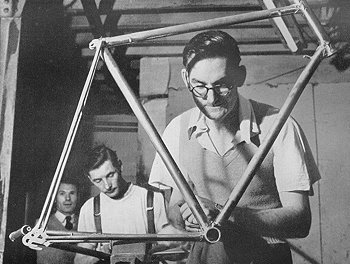
Hand-filing a Viking racing frame. |
|
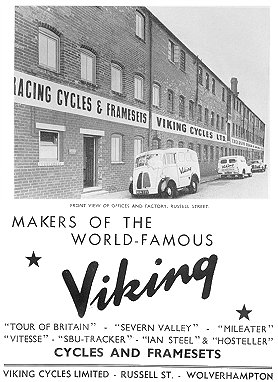
Merridale Works. |
Production at Russell Street began in a small part
of the works, but as sales increased the company expanded into
other parts of the works including the central courtyard. The
bicycles were designed by Reg Davies, who was an experienced
club rider and so had the necessary experience to design a good
racing machine. The machines were built to a high standard using
seamless T.I. tube or Reynolds type 531 butted tube. The best
lightweight lugs were used and the wheels were assembled from
brought-in rims, hubs and spokes. Chromium plating was done
locally, some customers even asked for the frame itself to be
chromed. Every frame was superbly finished with a coat of high
quality primer and several coats of paint, each being
rubbed-down before the next was applied. Great attention was
paid the braising because the strength of the frame depended
upon this. |

The factory in Russell Street.
| Production continued to increase, reaching a peak
in 1963 when 20,000 machines were produced with a workforce of
around 70. Two of the company’s key people were Bob Thom and Les
Bremner.
As mentioned earlier, Bob started as racing team
manager but soon progressed to Sales Manager, he more than
anyone else built the companies reputation for lightweight
machines. Les Bremner was Works Manager and a very good
organiser. He retired to Miami a few years ago. |

The building shop at Merridale Works. |
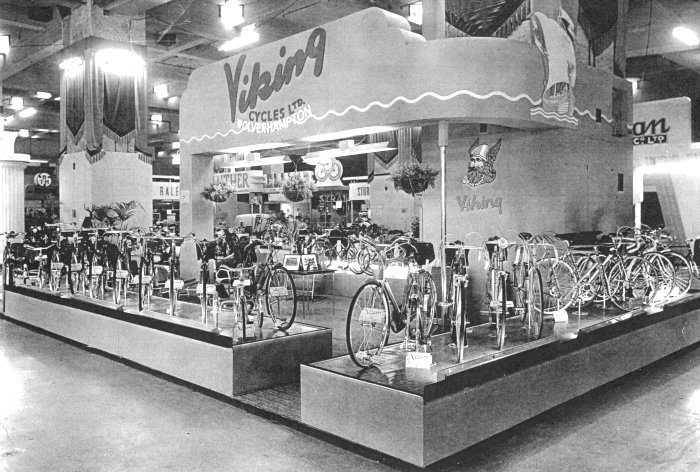
Viking Cycles at an exhibition. Courtesy
of Vic Davies.
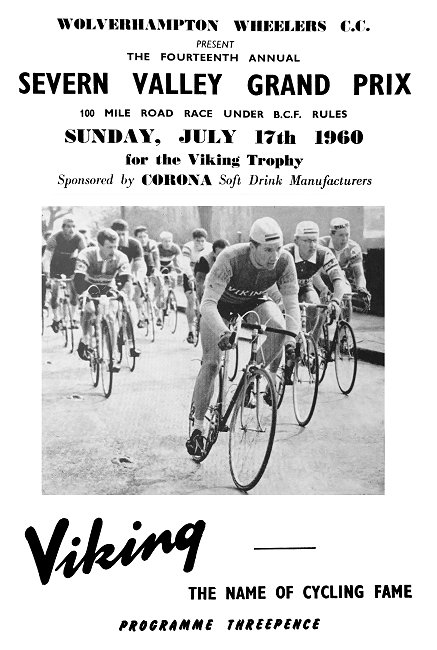
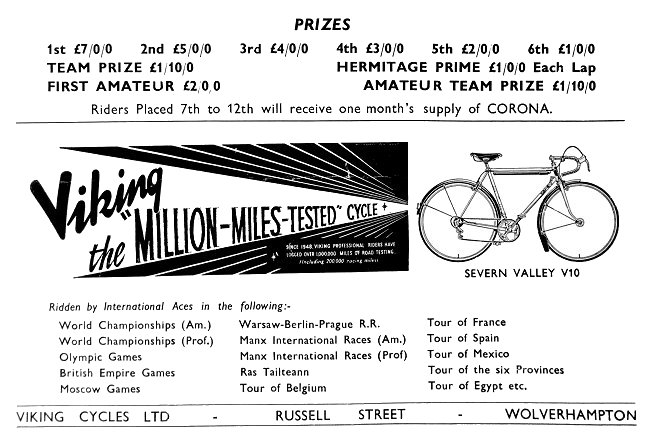
Page 2 of the programme above.
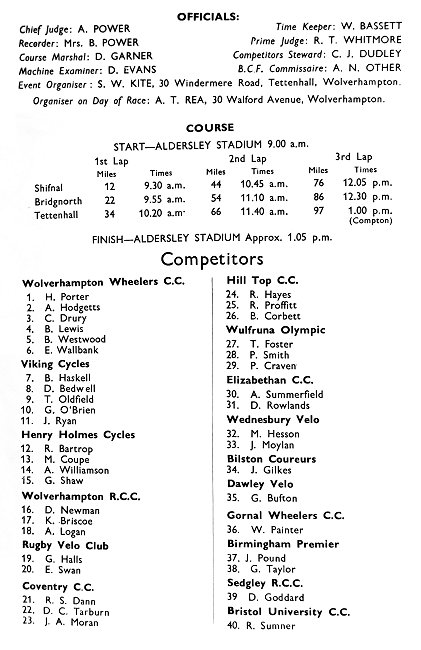
Page 3 of the programme.

| This advert from
1964 shows the wide range of products that were sold in
the Princess Street shop. |
|
Although the production of juvenile machines
partly compensated for the loss of the lightweight club-market,
it wasn’t enough to save the company and production ended in
1967. During the last two years Reg Davies worked with Frank
Williams who was assembling Viking bicycles and on his
retirement the company closed. The business was purchased by two
Americans who started it up again in Londonderry. Viking Cycles
still exists in Northern Ireland today, but as a bicycle
assembler, assembling cycles from brought-in spares. |
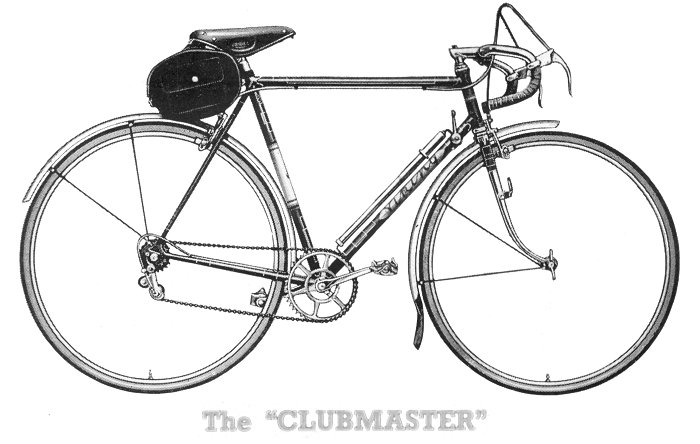
The Clubmaster bicycle of
1961 was designed for the hard riding clubman. It had an 'SS'
frame and forks, G.B. alloy brakes, Williams C34 chain wheel
set, Perry or Coventry chain and a Simples 3 speed Gear. The
machine sold for £30.10s.0d. Photo courtesy of the late Jim Boulton. |
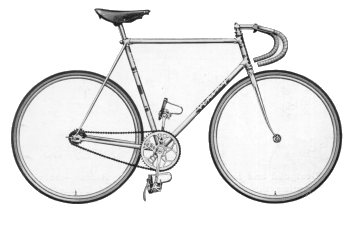 |
The Trackmaster bicycle of
1961 had an 'SS/T' frame and forks, Reynold twin roller chain,
fixed gears and Brooks B17 saddle. The machine sold for
£36.15s.0d.
Photo courtesy of the late Jim Boulton.
|
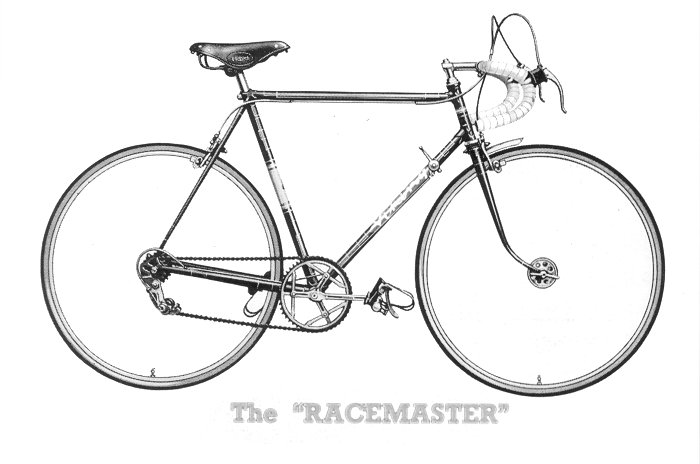
The Racemaster bicycle was
an extremely reliable competition machine. It had an 'SS' frame
and forks, Williams or continental chain wheel set, Simplex 4
speed gear and a Brooks B17 saddle. Photo courtesy of the late Jim Boulton. |
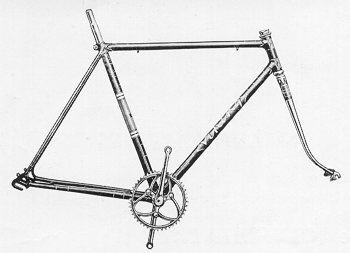 |
The 'SS' frame set used
feature-cut lugs and Reynolds 531 butted tubes, stays and
blades. It had a 41.5inch wheelbase and was available in sizes
from 21 to 24inches. It accepted 26inch or 27inch wheels and had
chrome plated front forks.
Photo courtesy of the late Jim Boulton.
|
| The 'SS/T' frame set used
Reynolds 531 butted tubes, had a 40.5inch wheelbase and
chrome plated front forks.
Photo courtesy of the late Jim Boulton.
|
 |
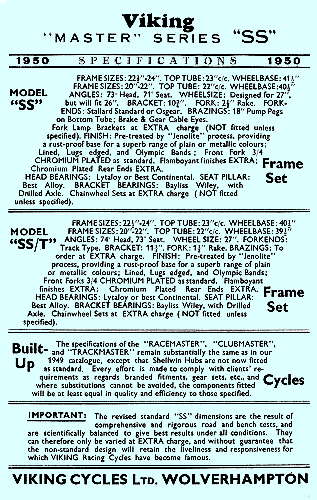
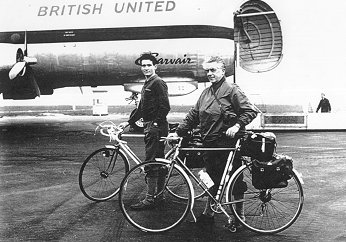 |
Vic Davies and his father
Reg Davies pushing their cycles out to the ferry aircraft at
Southend Airport, on route to Switzerland at the start of a
cycling holiday.
Courtesy of Vic Davies. |

A recently restored Trackmaster.
| Sadly for Reg, his wife Mair suffered a stroke in 1971
and he cared for her until her death in 1981. They were a
close couple who had been married for 48 years, and her
death was a bitter blow. After a period of depression he
began to concentrate on the loves of his life; music and
poetry. In his teens he played the piano, composed music,
and wrote many poems. He now began to write anew and
composed many piano, choral works and poems. He also
produced a book of his poetry called "Broken Glass" to raise
funds for Compton Hospice. His creativity knew no bounds.
In the late summer of 1984 he donned a pair of pumps and
jogged down his garden path into Poplar Road, Penn Fields,
Wolverhampton. After about 50 yards he was out of breath,
but six months later at the age of 77 he completed the Black
Country Marathon, none stop, and a new running career began.
Between 1984 and 1994 Reg ran a total of 9,000 miles,
competing in ten full marathons and dozens of shorter races.
This was an incredible record for someone of his age, but
all the more incredible because at the time he was an
asthmatic and suffered from Parkinson's disease and mild
arthritis. He became the oldest member of the "Running
Sixties" Club and was one of ten remarkable pensioners who
ran from John O'Groats to Land's End, and later from Paris
to London. He celebrated his 80th birthday by running ten
miles up and down Snowdon from Llanberis.
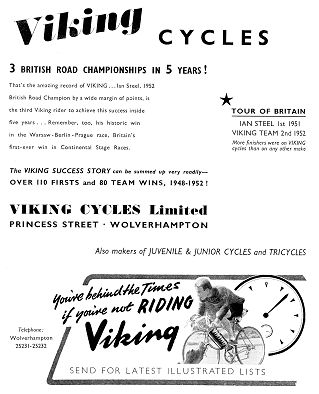
Reg did a lot of fund raising for charities. In 1988 he
ran with his son Vic from Wolverhampton to North Wales for
the Chest, Heart and Stroke Association, in memory of his
beloved wife Mair, and the following year participated in a
512 mile relay from Dundee to London, for the same charity.
Also in 1989 he was the first to finish the London Marathon
in the over 80s age group.
When his daughter-in-law, Celia, fell ill with cancer, he
helped Vic to raise over £7,000 for Wolverhampton's Royal
Hospital by running a double marathon relay from
Wolverhampton to the top of the Wrekin and back.
|
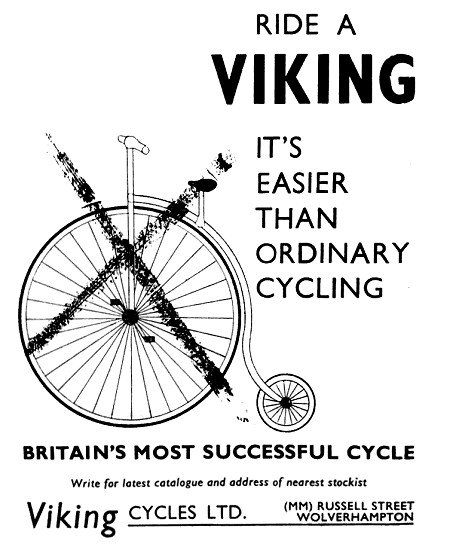 |
Sadly Celia died in October 1991 when Reg was about to
celebrate his 84th birthday by running 84 miles in a circuit
around West Park, Wolverhampton with a team from
Wolverhampton Road Runners.
He immediately re-dedicated the
run in her memory and in the process raised £2,500 for
Compton Hospice, where she had died.
During his running career Reg raised over £25,000 for
charity, became a Black Country celebrity and was greatly
respected by the national running fraternity.
His last fund
raising venture occurred on 22nd May, 1994, when at the age
of 87 he ran and walked the last 17 miles from London to
Brighton. He was joined by his son Vic and two of his
granddaughters. Sadly this was to be his last year, as he
died of cancer on 9th November, 1994. Reg was a truly
remarkable man. |
|

Reg Davies in later life. Courtesy of Vic Davies. |
|

An advert from 1966. |
I would like to thank Vic and Karen Davies for all of their help in
producing Viking’s history. Vic is Reg Davies’ son and he worked for the
company as Purchasing Director until 1966. Thanks also to
 |
Return to
the list
of manufacturers |
|
